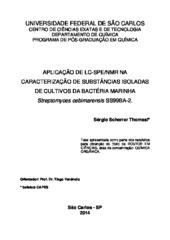Aplicacão de LC-SPE/NMR na caracterização de substâncias isoladas de cultivos da bactéria marinha Streptomyces cebimarensis SS99BA-2
Resumen
Marine microorganisms are living beings with extraordinary abilities, once they have developed physiological and metabolic capabilities that allow them to survive in an environment filled with adverse conditions, such as high pressure, excessive salinity and extreme temperatures. Thus, these living beings have great potential for the production of metabolites which normally cannot be produced by soil bacteria. The overall objective of this study was to elucidate the metabolite profile of the bacterium Streptomyces cebimarensis SS99BA-2 isolated from marine sediment in São Sebastião, a city located in the northern coast of São Paulo State, using the LC-SPE/NMR hyphenated technology. Ethyl acetate and butanol extracts of bacterial fermentation broths showed, respectively, biological activity against Escherichia coli and Candida albicans, and cytotoxic activity against tumour cells SF-295 (central nervous system). The optimization of the chromatographic conditions, together with the optimization of parameters for SPE retention, and for NMR acquisition and processing, led to the identification of at least eight known substances. This strategy did not require bench isolation methods, from very small amounts, approximately 3 mg, of crude extracts and permited to identify: maltol, 5-hydroximaltol, 4-hydroxibenzoic acid, N-acetyltyramine, isomaltol, 3-(N)-propanesulfonic acid, dehydroxinocardamine and nocardamine. In addition, six new compounds were isolated, including four belonging to a rare class of pyrazin-2(1H)-onic secondary metabolites named: giovaninone A, giovaninone B, giovaninone C and giovaninone D, and two belonging to an extremely cytotoxic class of antitumor phosphated polyketides: thomasicine A and thomasicine B. The results show that the LC-SPE/NMR coupling technology is extremely useful in the natural products field, since organic compounds can be identified in a rapid, safe and reproductible way. Moreover, it can be observed that the chemistry of marine microorganisms is still very little explored and reveal a promising field in the obtaining of potential candidates for pharmaceuticals, since these organisms are able to be cultivated in large scale through the use of bioreactors.
